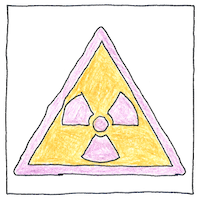Henri Becquerel, Marie Curie, Pierre Curie, Ernest Rutherford, Frederick Soddy
physics

|
Radioactivity
A crust of phosphorescent uranium salt darkens a photographic plate when left out in the sun and when moved to a dark drawer continues to darken the photographic plate. Henri Becquerel thought that rays of longer duration continued to be emitted from the excited material. Becquerel compared this effect to the effects of the X-rays studied by Röntgen. Within two months Becquerel tested non-phosphorescent uranium salt and correctly concluded that uranium spontaneously emitted radiation.
Caution—radioactive materials
They didn’t know, back then, that radiation could kill you, that ionizing rays can knock loose the rungs of DNA upon which the production of new blood cells depends. Wilhelm Röntgen took precautions against the unknown, but Marie Curie died of aplastic anemia; her bone marrow could not adequately replenish her red blood cells. Today, Marie’s papers are kept in lead-lined boxes and you need a lead-lined suit to read them.
Transmutation of elements
Ernest Rutherford and Frederick Soddy showed that radioactivity occured when atoms spontaneously disintegrated into other types of atoms. Rutherford was the first person to deliberately change one element into another. He bombarded pure nitrogen with alpha particles to convert nitrogen to oxygen. Transmutation of elements was the goal of alchemissts, including Newton, for four millennia. Little had they realized that unleashing atomic forces would bring so much destruction upon the world.



Wilhelm Röntgen had already found that X-rays darkened a photographic plate. Henri Becquerel initially thought that fluorescence produced X-rays, so, in 1896, he put a crust of phosphorescent uranium salt over an unexposed photographic plate protected by “two sheets of very thick black paper”; he expected that the plate would darken under the sample when he put it in sunlight, and it did. But Becquerel became curious when the plate darkened on a cloudy day when left in a drawer, so he tested a non-phosphorescent uranium salt and the plate still darkened.
Later, Becquerel showed that uranium did not emit X-rays because X-rays can be deflected by a magnetic field, and the radiation from uranium could not.
Marie Curie was Becquerel’s doctoral student. Subsequently, she and her husband, Pierre, isolated polonium and radium from uranium ore.
Ernest Rutherford named the three types of particles emitted during radioactive decay—alpha, beta, and gamma particles—based on their ability to penetrate other materials. Rutherford showed that alpha particles were helium nuclei (now known as protons); he helped demonstrate the nuclear nature of atoms, and he proposed that nuclei were composed of equal numbers of protons and neutrons (then unobserved). Rutherford was the first to notice that radioactive elements have a constant half-life, and used this to determine the age of the earth. A speech by Rutherford inspired Leó Szilárd to propose controlled energy-producing nuclear chain-reactions.
See also in The book of science:
Readings in wikipedia:
Other readings: